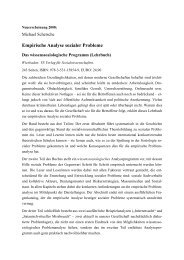Tätigkeitsbericht 2002/2003 - IGPP
Tätigkeitsbericht 2002/2003 - IGPP
Tätigkeitsbericht 2002/2003 - IGPP
Sie wollen auch ein ePaper? Erhöhen Sie die Reichweite Ihrer Titel.
YUMPU macht aus Druck-PDFs automatisch weboptimierte ePaper, die Google liebt.
78 Bender Institute of Neuroimaging<br />
optimale Informationsverarbeitung zu gewährleisten.<br />
Stark (Koordinator)<br />
Zerebrale Aktivierung von Patienten mit Angststörungen<br />
bei linguistischer Bedrohung – Vergleich von Prä- und<br />
poststationärer Psychotherapie<br />
Die Studie wurde in Zusammenarbeit mit der<br />
Abteilung für Psychosomatik am Klinikum der Justus-<br />
Liebig-Universität Giessen durchgeführt. Untersucht<br />
wurden 10 Panikpatienten und 10 Kontrollpersonen.<br />
In der Untersuchung wurden den Probanden positive,<br />
negative und neutrale Wörter präsentiert, wobei eine<br />
zusätzliche kognitive Aufgabe erledigt werden musste:<br />
In einem sogenannten Go-NoGo Paradigma sollten die<br />
Versuchsteilnehmer auf alle Wörter, die nicht kursiv<br />
gedruckt waren, mit einem Tastendruck reagieren (Go)<br />
und diese Reaktion unterdrücken, sobald ein Wort kursiv<br />
dargestellt war (NoGo). Erwartet wurde, dass Patienten<br />
insbesondere auf negative Wörter, die häufig<br />
im Zusammenhang mit ihren Panikgedanken standen<br />
(z. B. “Tod”) anders reagieren als gesunde Vergleichsprobanden<br />
und dass ihre exekutiven Funktionen – hier<br />
die Unterdrückung einer motorischen Reaktion – durch<br />
die emotionale Belastung beeinträchtigt werden. Es<br />
zeigte sich, dass Panikpatienten langsamer auf die<br />
angstbesetzten Wörter reagierten und eine veränderte<br />
Hämodynamik in den verschiedenen Bedingungen<br />
zeigten als die gesunden Versuchsteilnehmer.<br />
Stark (Koordinator)<br />
Instruktionsabhängige zerebrale Aktivierung beim<br />
Beobachten von motorischen Bewegungen<br />
Ausgangshypothese dieser Studie, die in Zusammenarbeit<br />
mit dem Sportwissenschaftlichen Institut der Universität<br />
Giessen durchgeführt wurde, war, dass die<br />
Beobachtung von motorischen Bewegungen zu unterschiedlichen<br />
Hirnaktivitäten führt, je nachdem, welche<br />
Intention der Beobachter beim Betrachten der Bewegungsabläufe<br />
hat. Zu diesem Zweck wurden 10 Sportstudentinnen<br />
im MRT mehrere Filme gezeigt, in denen<br />
eine Abfolge von gymnastischen Bewegungsabläufen<br />
dargestellt waren. Aufgabe der Probandinnen war<br />
entweder, die gezeigten Übungen unter verschiedenen<br />
Kriterien zu bewerten oder sich die Abläufe so<br />
einzuprägen, dass sie später selbst ausgeführt werden<br />
konnten. Erwartungskonform zeigte sich, dass<br />
tatsächlich das gleiche Bildmaterial zu sehr unterschiedlichen<br />
Aktivierungen im Gehirn führen kann,<br />
je nachdem welche kognitive Aufgabe den Probanden<br />
beim Betrachten der Filmsequenzen gegeben wurde.<br />
Erwartungskonform zeigte sich, dass tatsächlich das<br />
gleiche Bildmaterial zu unterschiedlichen Aktivierungen<br />
insbesondere im supplementären motorischen<br />
Areal (SMA) führten: Unter der Beurteilungsbedingung<br />
lag die Hauptaktivität im pre-SMA (anteriore<br />
SMA), unter der Einprägebedingung im SMA proper<br />
(posteriore SMA). Dieser Befund deckt sich gut mit<br />
Berichten in der Literatur, die zeigen, dass die poster-<br />
Brain activation of patients with anxiety disorder caused<br />
by verbal threat – comparison of before and after an inpatient<br />
psychotherapeutic treatment<br />
The study was conducted in cooperation with the department<br />
of psychosomatic medicine at the University<br />
of Giessen. Ten patients with panic disorder and 10<br />
controls were examined. Words with emotional positive,<br />
negative and neutral meaning were presented<br />
while subjects had to perform a cognitive task. During<br />
the go-nogo paradigm the subjects were instructed<br />
to react to all words which were not printed in italics<br />
with a key press (go) and to suppress this motor<br />
reaction by words in italics (nogo). It was expected<br />
that patients with panic disorder responded differently<br />
especially to words, which corresponded to their panicrelated<br />
thoughts (e. g. ‘death’) in comparison to controls.<br />
Furthermore, the suppression of the motor reaction<br />
(an executive function) should be impaired by<br />
emotional stress. The results showed that the reaction<br />
times of the patients towards the panic-related words<br />
were slower than these of the controls. Additionally,<br />
the brain activation patterns of the two groups significantly<br />
differed during the different conditions.<br />
Stark (coordinator)<br />
Instruction-dependent brain activation during the observation<br />
of whole-body movements<br />
The starting hypothesis of this study, which was conducted<br />
in cooperation with the Institute of Sports at<br />
the University of Giessen, was that the brain activation<br />
during the observation of whole-body movements<br />
differ depending on the intention of the observer. In<br />
this study 10 video clips with sequences of gymnastic<br />
movements were presented to ten females – all sport<br />
students. The tasks of the subjects were either to<br />
evaluate the presented movements along with different<br />
criterions or to memorize the sequences so that they<br />
could repeat the movements afterwards. As expected,<br />
the different instructions resulted in different brain activation<br />
maps, especially in the supplementary motor<br />
area (SMA). During the evaluation condition the activity<br />
was observed mainly in the pre-SMA, whereas<br />
the memory condition resulted in increased activation<br />
of the SMA proper. This result is in good correspondence<br />
with the literature which could demonstrate that<br />
the SMA proper is involved during the preparation<br />
of a actual movement while the pre-SMA is activated<br />
by motor-related cognitive tasks (e. g. the selection of<br />
appropriate motor behaviour). Additionally, subjects<br />
imagined the memorized movements inside the scanner.<br />
The observed activated brain areas during this<br />
condition were comparable with the areas, which are<br />
involved during an actual motor movement, but redu-


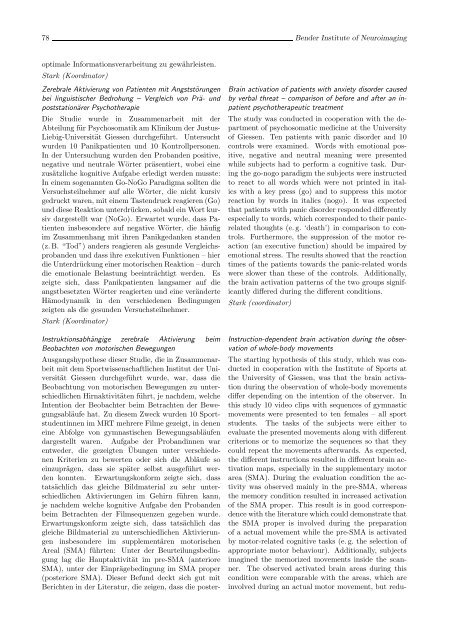
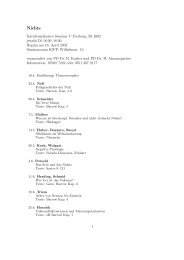
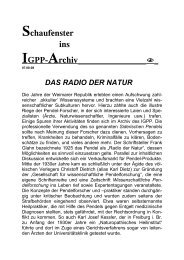
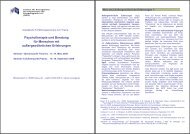
![Findliste Nachträge1 [pdf] - IGPP](https://img.yumpu.com/22552359/1/184x260/findliste-nachtrage1-pdf-igpp.jpg?quality=85)

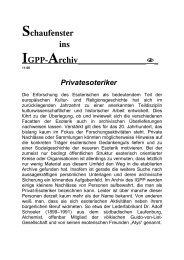
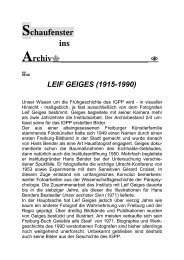
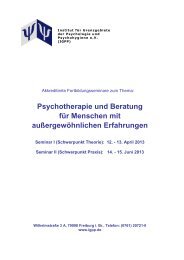
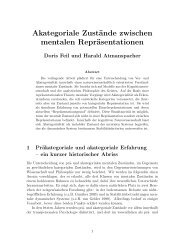
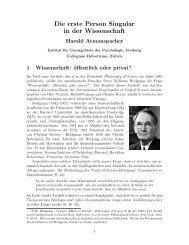
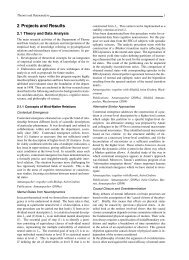
![Findliste [pdf] - IGPP](https://img.yumpu.com/22552265/1/190x245/findliste-pdf-igpp.jpg?quality=85)

